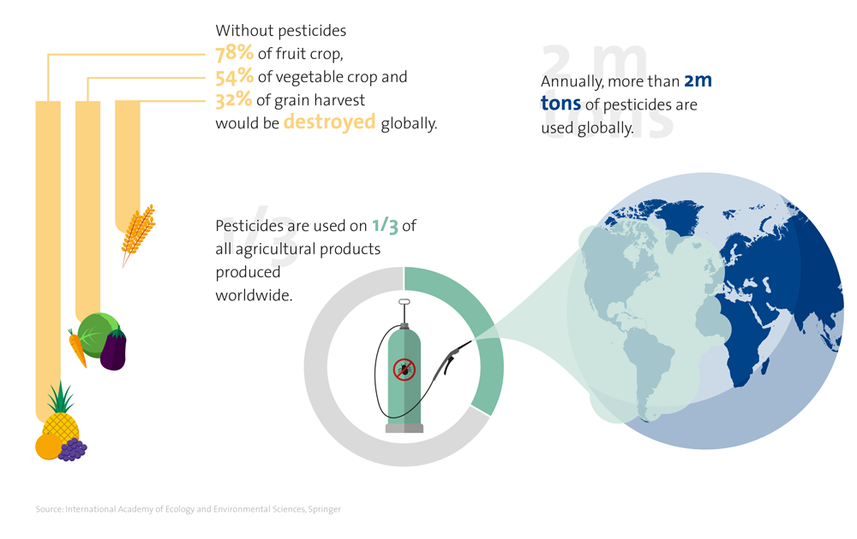Pesticides in agriculture: a necessary evil?
Handling synthetic pesticides safely
The use of pesticides is a hotly debated issue in agriculture, science, and among the general public. Synthetic pesticides deliver higher yields for farmers and allow them to meet the growing demand for food worldwide. However, the impact on human health and the environment is the subject of controversial debate. Many farmers are also aware of the issue but it is generally not possible to dispense with pesticides entirely.
The early bird catches the worm – and farmers usually tend to their fields in the early morning hours, just like the old adage goes. The advantage: fertilizers and pesticides evaporate more slowly and remain on the field. Farmers usually use long spraying arms to apply the protective mist to the plants. After just 15 minutes, the leaves have absorbed the fine droplets. But many farmers and researchers are questioning how much of the active substance actually remains on the crop, and how much of it never reaches the plant and is simply carried away by the wind. The effects of pesticides on human health and the environment are widely debated by the public. But what exactly are the effects of the fog that shimmers above the fields in the morning sun?
A toxic mix of substances
Farmers mix together a variety of pesticides in their agitator drums. These can be categorized into three main groups: herbicides, fungicides, and insecticides. Commonly used insecticides are organic phosphates (OPP) or the controversial neonicotinoids. They keep harmful insects such as aphids at bay in the field, and voracious bugs like the granary weevil off the harvest in storehouses. Most insecticides attack the nervous system of the intended victims. OPPs, for example, inhibit the acetylcholinesterase enzyme and can cause convulsions.
However, their toxicity makes them harmful to all living beings. The fear is that even beneficial pollinators, such as bees, are affected by the pesticide. OPPs also pose a risk to human health. When these substances are swallowed or inhaled, they can trigger a condition known as cholinergic syndrome. Symptoms can include coordination difficulties, coma, and spasms of the respiratory tract.
The most widely used herbicide in the world is glyphosate. This substance is the active ingredient in the Roundup pesticide. Roundup is used for weed protection on almost all conventional fields. The substance inhibits a plant enzyme and thus suppresses their growth. Glyphosate has long been suspected of causing cancer in humans. Residues of this substance are frequently found in food items and in the hair of field workers. The workers come into direct contact with Roundup when it is sprayed in the field. For this reason, environmentalists are calling for a ban on the substance. However, the European Food Safety Authority does not believe that the carcinogenic effect of glyphosate has been demonstrated. The herbicide is therefore still approved for use in the European Union until at least 2022.

A necessary evil
Dispensing with glyphosate altogether, however, can have serious consequences for the harvests of farmers. In the tea plantations of Sri Lanka, where the use of Roundup was stopped, the fields became overgrown with weeds and the harvest declined sharply. In the first year alone, farmers suffered a drop of 11%. Corn, chili, and finger millet fared even worse with up to 55% of the harvest being lost.
Nevertheless, some farmers still choose to forgo synthetic pesticides in favor of organic farming methods. Ironically, organic farming also uses pesticides. Although synthetic substances are prohibited, natural substances such as copper can still be used to protect the plants. These substances are absorbed by the plants and soil and only present a minor health risk to beneficial soil organisms.
Farmers and public authorities are aware of the necessity and risks of pesticides. This is why the use of these substances is strictly regulated. Nowadays, pesticides are applied much more sparingly and selectively, thus reducing residues in food, groundwater, and airborne drift. Agricultural workers, however, are still at risk. They can come into contact with the chemicals when the pesticides are sprayed.
Safety first
Wherever pesticides are sprayed, it is critical that field workers are effectively and safely protected. This is regulated in Europe by EU standard EN 15695-2 (2009) for systems designed to ensure the purity of air in agricultural tractors and self-propelled sprayers. The standard stipulates that mists, aerosols, and gases that accumulate in the air when liquid fertilizers are used must not penetrate into the driver’s cab.
Sophisticated solutions are called for to ensure compliance with these extremely stringent safety requirements. One example that works: the multi-stage cabin category 4 filter design concept from Freudenberg Filtration Technologies. The cabin category 4 filter solutions offer maximum protection for the drivers of agricultural vehicles.
The farmers must take responsibility for their immediate environment by using pesticides in low wind conditions and as sparingly as possible. Filtration solutions from Freudenberg Filtration Technologies play an important role in the protection of machine operators.











